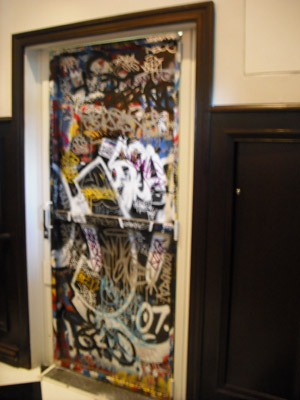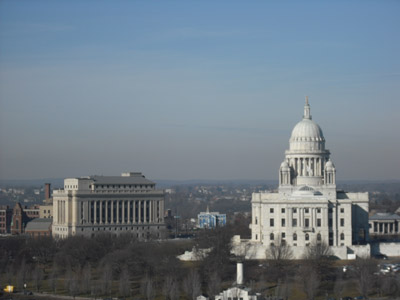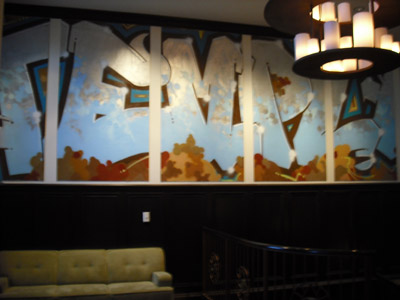The Renaissance Providence has employees responsible for knowing the building’s history. During the elevator ride up to your room the storyteller will give you a summary of what I wrote in the history, point out blue prints of the Freemasons’ original plans for the building hanging in the hallways and can answer questions such as how they cleaned the limestone façade. But is he really telling the story of the building- isn’t he telling the story of Providence over the last century? The storyteller position qualifies the building as a milieux de memoire.
The Renaissance Providence however, is also a lieu de memoire. During the many years the building was supposedly abandoned and thus incapable of being an event-place, the Masonic complex became a shelter for the homeless, and a temple for graffiti writers. The building space was experienced by these writers, who bonded over the repeated performance. The experience of sneaking in by climbing onto the roof of an adjacent church hall and into a window of the temple is passed on from writer to writer. Inside the remains of past visitors are written on the walls, the writer realizes he is apart of a group, a community. While a collective memory among graffiti writers who visited developed, a specific individual memory developed as well and is revealed through online forums and sites such as Art in Ruins (www.artinruins.com) where writers and graffiti enthusiasts share pictures and stories from the temple.
The most famous piece of graffiti on the Masonic complex was written by Juner, who lowered himself of the roof, onto a ledge six stories high to write “Temple of Junerism.” The words greeted locals riding the bus to work and visitors driving down I-95, seconds after passing the state house and led to the nickname, Temple. It appeared that the writers of Providence had found an event for the building at a time when no institution could afford to assign it one.
During restoration all the graffiti on the facades was washed off, while the interior was covered with freshly painted walls. Although the memory of the graffiti scene in the Temple resides mostly in the minds of those who experienced it and in the online forums where the stories are shared, the Renaissance Hotel attempts to uphold these memories of the Temple, the event-place and it’s role as a lieu de memoire by featuring pictures of the original graffiti on it’s walls in frames throughout the hallways. The graffiti pieces however seems to fit more into history once placed in the frames in the hallways. Additionally, a restaurant downstairs, called the Temple, features tagged backdoors, pieces to create more inviting nooks, as well as a piece the owner invited Juner to complete of the word “temple” at the head of the spiral staircase leading to the bar, paying respect to the memories washed off the walls. It is interesting how the design of the Masonic Temple acknowledges it’s past and it’s role in holding onto and letting go of memories both intentionally and unintentionally.



